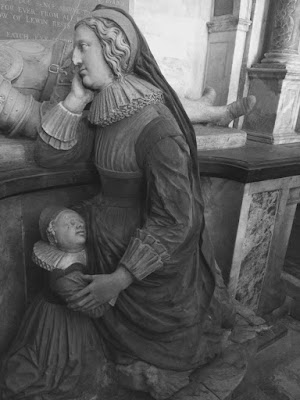Yesterday I was walking, with walker friends, in deepest Kent. Our objective - mine, anyway - was the little church at Otterden, an unpromising Georgian box (the private chapel of the 'big house', Otterden Place) which contains a range of fine monuments, including one by our old friend Epiphanius Evesham.
It's not a church to visit casually, being almost permanently locked; but, by prior arrangement, the key - a large and serious key - can be had from the occupants of the big house. First impressions of the church interior are little better than those of the exterior - until you notice the monuments against the North and South walls. Three of these amount to a neat summary of English monumental art in the Jacobean period, ranging in quality from good to better to best: two standard forms competently executed and one work of art of a quite new kind. The earliest of these three, which memorialises William Lewin, has two recumbent effigies, man and wife, lying atop a tomb chest, with numerous offspring lined up along the base. Everything is straight off the production line and there is no real individual life in any of the figures. More interesting is a wall monument of a decade later that follows another standard pattern - man and wife praying, facing each other, at a prayer desk (with a daughter kneeling behind the mother). More unusually, there is a baby in a canopied cot separately figured on a shelf below. The modelling of the figures is rather better, but still pretty stiff and lifeless. Both of these monuments might shine more brightly in another church, one where they were not so entirely overshadowed by the sheer brilliance of Otterden's third Jacobean monument - the Evesham*.
Sir Justinian Lewin, who died in 1620, is shown lying in his armour, his body not in repose but stiffened in death. His grieving wife kneels at the side of the chest on which he lies, her chin on her hand, her eyes, full of sorrow, gazing at his face. This is powerful - and original - enough, but there is still more emotion in the stricken, bewildered face of the child who kneels beside her, tugging at her skirt, desperate to be comforted. This is monumental art at its most convincingly expressive; there is nothing stylised or artificial or about this portrayal of grief - as with Evesham's Lynsted monument, this is the real thing.
Sir Justinian, who was a gentleman of the privy chamber to James I, was the second son of William Lewin, and therefore has the rare distinction of appearing on two of the church's monuments - as a generic child on his father's and as a fully individual dead man on his own.
One more thing about Otterden: in 1729, in the grounds of Otterden Place, the Rev. Granville Wheler, the house's then owner, and Stephen Gray succeeded in transmitting electrical current for an unprecedented 860ft along a length of oiled thread. You can read more about that here...
* The monument is unsigned, but is confidently (and surely rightly) attributed to Epiphanius Evesham - whose else could it be?
Saturday, 8 July 2017
Subscribe to:
Post Comments (Atom)



So was this monument moved from the original church that was demolished?
ReplyDelete